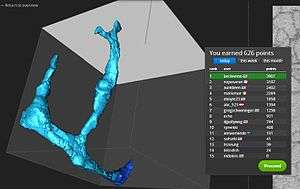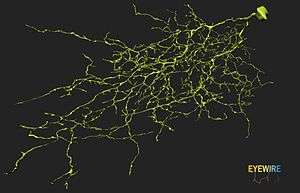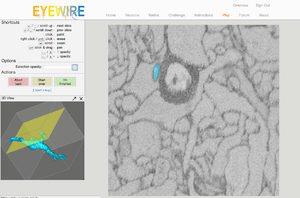Eyewire
| Eyewire | |
|---|---|
 | |
| Developer(s) | Wired Differently, Inc. (formerly Massachusetts Institute of Technology) |
| Director(s) | Amy L Robinson |
| Platform(s) | Webbrowser (WebGL) |
| Release date(s) | December 10, 2012 |
| Genre(s) | Puzzle, Citizen Science |
Eyewire is a game to map the brain that originated at Sebastian Seung's Lab at MIT.[1] This citizen science human-based computation game challenges players to map 3D neurons in a retina. Eyewire was officially launched on December 10, 2012 and has since grown to over 200,000 players from 150 countries.[2] The game is led by non-profit MIT-spinoff Wired Differently, Inc., in partnership with Seung Lab at Princeton University with data generated by the Max Planck Institute for Medical Research.[3]
Eyewire gameplay advances neuroscience by helping researchers discover how neurons connect to process visual information.[4][5] Anyone, anywhere can help neuroscientists develop advanced artificial intelligence and computational technologies for mapping the connectome.[3] In Eyewire, gamers solve 3D puzzles. As they solve the puzzles, they are actually reconstructing 3D models of neurons at nanoscale resolution from electron microscopy images. Eyewire requires no scientific background to play and works best on high speed internet.
Eyewire has been featured by WIRED,[6] Nature,[7] Forbes,[8] Scientific American,[9] NPR[10] and more.[3]
How to Play
Eyewire challenges players, "Eyewirers," to map neurons in 3D. Upon registering, players are automatically directed through a tutorial that explains the game. Supplementary video tutorials are available on the Eyewire Blog.
In Eyewire, a gamer is given a cube with a partially reconstructed neuron branch stretching through it. On the right side of the screen there is a black-and-white image of the cross sections of neurons (Figure A, below). A player learns to "color" inside a gray outline of a single neuron branch, which usually extends from one side of the cube to another. This generates volumetric reconstructions, branch by branch.
Multiple players map each cube and their work is compared. Advanced players, Scouts and Scythes, oversee the work of the global community. These players have the power to extend branches and remove erroneous segments (nicknamed "mergers").
Detailed Instructions
The player's task is to select the areas that the AI missed, thus improving the trace of the neuron. Some improvements may merely fill in holes. Others may extend a branch, and others may find new branches that the AI missed. In the interface, a three-dimensional view shows the trace of the neuron through the volume, while the player can scroll up and down in the two-dimensional slices to follow the path. The player clicks on areas in the slices to add them to the trace. The AI automatically fills in the parts of the neuron that it detects are part of the player's clicked area. Once the player has decided the task is complete, the player submits the task and is presented with another task.

Scoring
Each volume is presented to three to five different players, and the trace chosen by the majority of the players is accepted. Any new branches may result in new volumes being explored. For the beta, players get points based on whether their tracing matches the majority of other players' tracings and based on the new amount of neural volume found.
Goal
The goals of Eyewire are to identify specific cell types within the known broad classes of retinal cells, and to map the connections between neurons in the retina, which will help to determine how vision works.[11][12] Eyewire is part of a larger effort called WiredDifferently, whose goal is to show that the uniqueness of a person lies in the pattern of connections between their neurons, or their connectome.[13][14]
- The first immediate goal is to reconstruct the three-dimensional shapes of retinal neurons from two-dimensional images.[15]
- The second goal is to identify the synapses to determine what the connections between the mapped neurons are.
- The final goal is to relate the connectivity with the known activity of the neurons.
Methods
The activity of each neuron in a 350×300×60 μm3 portion of a retina was determined by two-photon microscopy.[15] Using serial block-face scanning electron microscopy, the same volume was stained to bring out the contrast of the plasma membranes, sliced into layers by a microtome and imaged using an electron microscope.
A neuron is selected by the researchers. The program chooses a random cubic volume associated with that neuron for the player, along with an artificial intelligence's best guess for tracing the neuron through the two-dimensional images.[16]
More information is available on the Eyewire Wiki.
Accomplishments
- Eyewire neurons featured at 2014 TED Conference Virtual Reality Exhibit.[17][18]
- Eyewire neurons featured at US Science and Engineering Expo in Washington, DC.[19]
- Eyewire won the National Science Foundation's 2013 International Visualization Challenge in the Games and Apps Category.[20]
- An Eyewire image by Alex Norton won MIT's 2014 Koch Image Gallery Competition.[21]
- Eyewire named one of Discover Magazine's Top 100 Science Stories of 2013.[22]
- Eyewire named top citizen science project of 2013 by SciStarter.[23]
- Eyewire won Biovision's World Life Sciences Forum Catalyzer Prize on March 26, 2013.[24]
- Eyewire named to top 10 citizen science projects of 2013 by PLoS.[25]
Additional Images
-

A neuron mapped by Eyewirers
-

Growth of a Neuron. GIF created from screenshots of the first community mapped neuron
-

Here, in an older version of Eyewire, the player has extended the neuron's branch
References
- ↑ http://www.nytimes.com/2015/01/11/magazine/sebastian-seungs-quest-to-map-the-human-brain.html
- ↑ http://blog.eyewire.org/infographic/
- 1 2 3 "About << Eyewire". Retrieved April 17, 2014.
- ↑ Tinati, Ramine; Luczak-Roesch, Markus; Simperl, Elena; Hall, Wendy (2016). "Because science is awesome: studying participation in a citizen science game". Proceedings of the 8th ACM Conference on Web Science: 45–54. doi:10.1145/2908131.2908151.
- ↑ Tinati, Ramine; Luczak-Roesch, Markus; Simperl, Elena; Shadbolt, Nigel; Hall, Wendy (2015). "'/Command' and Conquer: Analysing Discussion in a Citizen Science Game". Proceedings of the ACM Web Science Conference. doi:10.1145/2786451.2786455.
- ↑ "Eyewire in WIRED << EyeWire". Retrieved April 17, 2014.
- ↑ "Eyewire on Nature Blogs << Eyewire". Retrieved April 17, 2014.
- ↑ "Eyewire in Forbes << Eyewire". Retrieved April 17, 2014.
- ↑ "Eyewire in Scientific American << Eyewire". Retrieved April 17, 2014.
- ↑ "EyeWire on NPR << Eyewire". Retrieved April 17, 2014.
- ↑ "Retina << Eyewire". Retrieved March 27, 2012.
- ↑ "Eyewire". Retrieved March 27, 2012.
- ↑ "WiredDifferently". Retrieved March 27, 2012.
- ↑ Seung, Sebastian (2012). Connectome: How the Brain's Wiring Makes Us Who We Are. Houghton Mifflin Harcourt. ISBN 978-0547508184.
- 1 2 "Challenge << Eyewire". Retrieved March 27, 2012.
- ↑ Sebastian Seung (March 18, 2012). "Very small sections of neuron". Retrieved March 27, 2012.
A few more words of explanation for the curious...you color neurons on Eyewire by guiding an artificial intelligence (AI). The AI was trained to color the branches of neurons.
- ↑ http://blogs.technet.com/b/next/archive/2014/03/19/at-ted-worldwide-telescope-uses-oculus-rift-to-let-attendees-experience-the-universe.aspx#.U1AjneZdXKg
- ↑ http://blog.ted.com/2014/03/25/yes-thats-commander-chris-hadfield-wearing-the-oculus-rift-and-yes-the-internet-just-exploded/
- ↑ http://www.usasciencefestival.org/
- ↑ http://www.aaas.org/news/science-2013-international-science-and-engineering-visualization-challenge-winners-announced
- ↑ http://www.cell.com/pictureshow/koch2014winners
- ↑ http://discovermagazine.com/2014/jan-feb/76-science-for-the-people-by-the-people#.UuWOB2Qo6jk
- ↑ http://scistarter.com/blog/2014/01/top-13-citizen-science-projects-2013/#sthash.Rz9YzHim.dpbs
- ↑ http://www.biovision.org/focus2-catalyzer.html
- ↑ http://blogs.plos.org/citizensci/2012/12/31/top-citizen-science-projects-of-2012/